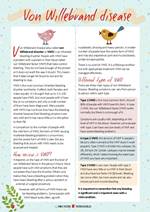Von Willebrand disease
Von Willebrand disease (also called von Willebrand disorder or VWD) is an inherited bleeding disorder. People with VWD have a problem with a protein in their blood called von Willebrand factor (VWF) that helps control bleeding. They do not have enough of the protein or it does not work the way it should. This means that it takes longer for blood to clot and for bleeding to stop.
There is no cure for VWD. It is a lifelong condition but with appropriate treatment VWD can be managed effectively.
The more common symptoms of VWD are:
- Frequent nosebleeds, or nosebleeds that are hard to stop
- Bruising easily
- Very heavy periods, or periods that last more than 8 days
- Bleeding for a long time from small cuts
- Bleeding from the gums, usually after trauma/injury
- Bleeding that continues for a long time after injury, surgery or dental work.
Women with VWD sometimes have abnormally heavy bleeding in the first couple of weeks after giving birth. They may also have quite a bit of bleeding between periods with ovulation (when the ovary releases an egg).
Less common symptoms that older people might experience are:
- Blood in faeces (poo) due to bleeding in the intestines or stomach
- Blood in urine due to bleeding in the kidneys or bladder.
People with severe forms of VWD, particularly type 3 VWD, may also have other bleeding problems similar to severe haemophilia, such as:
- Bleeding episodes that happen for no obvious reason
- Bleeding into joints and muscles which can cause swelling and pain.
 You can download our Female Factors von Willebrand disease PDF here. This contains more information on VWD in females including:
You can download our Female Factors von Willebrand disease PDF here. This contains more information on VWD in females including:
- How serious is VWD?
- Different types of VWD
- Bleeding symptoms of VWD
- How do you get VWD?
- How is VWD inherited?
- No family history of VWD
If you’d like to know more about bleeding disorders in young women download our Female Factors resource here